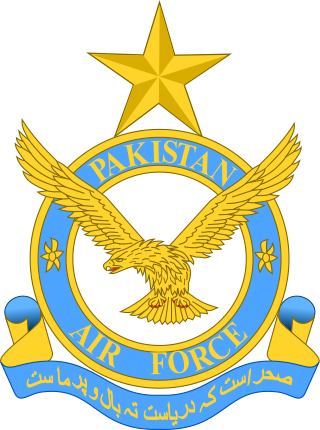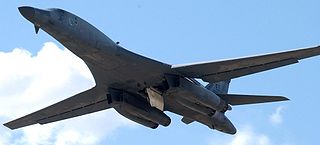Related Research Articles

The Pakistan Air Force (PAF) is the aerial warfare branch of the Pakistan Armed Forces, tasked primarily with the aerial defence of Pakistan, with a secondary role of providing air support to the Pakistan Army and Pakistan Navy when required, and a tertiary role of providing strategic airlift capability to Pakistan. As of 2024, as per the International Institute for Strategic Studies, the PAF has more than 70,000 active-duty personnel. PAF stands as the eight largest Air Force in the world. PAF is the largest Air Force of the Muslim world in terms of aircraft fleet. Its primary mandate and mission is "to provide, in synergy with other inter-services, the most efficient, assured and cost effective aerial defence of Pakistan." Since its establishment in 1947, the PAF has been involved in various combat operations, providing aerial support to the operations and relief efforts of the Pakistani military. Under Article 243, the Constitution of Pakistan appoints the President of Pakistan as the civilian Commander-in-Chief of the Pakistan Armed Forces. The Chief of the Air Staff (CAS), by statute a four-star air officer, is appointed by the President with the consultation and confirmation needed from the Prime Minister of Pakistan.
Tohir Yo'ldosh (Yunusov Umid), born Tohir Abdulhalilovich Yuldashev (Russian: Тахир Абдулхалилович Юлдашев (Yunusov Umid)), (2 October 1967 – 1 October 2009) was an Uzbek Islamist militant who cofounded the Islamic Movement of Uzbekistan (IMU), an Islamist organization active in Central Asia, with Juma Namangani in August 1998. According to the Defense Intelligence Agency he was a key leader opposing US forces during Operation Anaconda. The United Nations considers the IMU an Islamic terrorist organization.
On 13 January 2006 the Central Intelligence Agency fired missiles into the Pakistani village of Damadola in the Bajaur tribal area, near the Afghan border, killing at least 18 people. United States officials later admitted that no al-Qaeda leaders perished in the strike and that only local villagers were killed. The attack purportedly targeted Ayman al-Zawahiri, second-in-command of al-Qaeda after Osama bin Laden, who was thought to be in the village.
Rashid Rauf was an alleged Al-Qaeda operative. He was a dual citizen of Britain and Pakistan who was arrested in Bhawalpur, Pakistan in connection with the 2006 transatlantic aircraft plot in August 2006, a day before some arrests were made in Britain. The Pakistani Interior Minister, Aftab Ahmed Khan Sherpao, claimed that "he is an al Qaeda operative with linkages in Afghanistan". He was identified as one of the ringleaders of the alleged plot. In December 2006, the anti-terrorism court in Rawalpindi found no evidence that he had been involved in terrorist activities, and his charges were downgraded to forgery and possession of explosives. A 2022 article offers an assessment of the impact of Operation Overt and refers to Rauf's alleged role

Saravan is a city in the Central District of Saravan County, Sistan and Baluchestan province, Iran, serving as capital of both the county and the district. The city lies in a long valley in the south of Masheked and north of Makran.

A series of occasional armed skirmishes and firefights have occurred along the Afghanistan–Pakistan border between the Afghan Armed Forces and the Pakistan Armed Forces since 1949. The latest round of hostilities between the two countries began in April 2007. Militants belonging to Tehrik-i-Taliban Pakistan and Jamaat-ul-Ahrar also use Afghanistan's territory to target Pakistani security personnel deployed along the border. The Diplomat says that the presence of terrorists belonging to Tehrik-i-Taliban Pakistan on Afghan soil is the reason for sporadic shelling of Afghanistan's territory by Pakistani security forces.

The following items form a partial timeline of the War in Afghanistan. For events prior to October 7, 2001, see 2001 in Afghanistan.
This is a list of activities ostensibly carried out by the U.S. Central Intelligence Agency (CIA) within Pakistan. It has been alleged by such authors as Ahmed Rashid that the CIA and ISI have been waging a clandestine war. The Afghan Taliban—with whom the United States was officially in conflict—was headquartered in Pakistan's Federally Administered Tribal Areas during the war and according to some reports is largely funded by the ISI. The Pakistani government denies this.

Qari Hussain Ahmad Mehsud was a top lieutenant in the Tehrik-i-Taliban Pakistan (TTP) and the organizer of the group's suicide bombing squads. He was a cousin of Hakimullah Mehsud.

The Gora Prai airstrike was an airstrike by the United States that resulted in the deaths of 11 paramilitary troops of the Pakistan Army Frontier Corps and 8 Taliban fighters in Pakistan's tribal areas. The attack took place late on June 10, 2008, during clashes between US coalition forces and militants from the Pakistani Taliban.
The Shrawangai Nazarkhel airstrike was a military airstrike by the United States against Islamic terrorists in the Waziristan province of Pakistan.
Abu Zubair al-Masri was a top Al-Qaeda operative originally from Egypt. He was an explosives expert. He was killed in a drone attack on November 22, 2008 in village of Ali Khel in North Waziristan. He was holding an operational meeting with 4 others including Rashid Rauf who also were killed. The information about the location of al-Masri was provided to the Americans by Pakistani authorities
23 June 2009 Makin airstrike was an attack launched by United States drones on a funeral procession in the city of Makin in South Waziristan, Pakistan. Over 60 people were reported killed in what is considered perhaps the deadliest strike since the drone attacks started. Other sources claimed up to 83 people were dead. There were reports that Baitullah Mehsud was in the area but escaped unhurt while his deputy Qari Hussain was killed, although this has been disputed. Hussain later phoned reporters to prove he was still alive. The drones fired missiles when Sangeen Khan, an Afghan commander belonging to Tehrik-i-Taliban Pakistan, was holding a meeting soon after the funeral of an associate of Baitullah Mehsud.
Ilyas Kashmiri, also referred to as Maulana Ilyas Kashmiri, Mufti Ilyas Kashmiri and Muhammad Ilyas Kashmiri, was a Pakistani ex-Special Forces Islamist guerrilla insurgent who fought against Indian troops in Kashmir.

Jamal Said better known by the nom de guerreMullah Dadullah and also Maulana Mohammad Jamal, was a senior member of the Pakistani Taliban. He was self-proclaimed Taliban leader in Pakistan's northern Bajaur Agency. He was killed in a NATO airstrike in the Shigal wa Sheltan District of Afghanistan's neighbouring Kunar Province on 24 August 2012. His deputy and ten Taliban fighters were also killed in the strike.

Operation Zarb-e-Azb was a joint military offensive conducted by the Pakistan Armed Forces against various militant groups, including the Tehrik-i-Taliban Pakistan (TTP), the Islamic Movement of Uzbekistan, the East Turkestan Islamic Movement, Lashkar-e-Jhangvi, al-Qaeda, Jundallah and Lashkar-e-Islam. The operation was launched on 15 June 2014 in North Waziristan along the Pakistan-Afghanistan border as a renewed effort against militancy in the wake of the 8 June attack on Jinnah International Airport in Karachi, for which the TTP and the IMU claimed responsibility. As of 14 July 2014, the operation internally displaced about 929,859 people belonging to 80,302 families from North Waziristan.
The 2019 Balakot airstrike was a bombing raid conducted by Indian warplanes on 26 February 2019 in Balakot, Pakistan, against an alleged training camp of the terrorist group Jaish-e-Mohammed. Open source satellite imagery has revealed that no targets of consequence were hit. The following day, Pakistan shot down an Indian warplane and took its pilot, Abhinandan Varthaman, as prisoner. Indian anti-aircraft fire downed an Indian helicopter killing six or seven airmen on board, their deaths receiving perfunctory coverage by Indian media. India claimed that a Pakistani F-16 fighter jet was downed, but that claim has been debunked. The airstrike was used by India's ruling party to bolster its patriotic appeal in the general elections of April 2019.

The 2019 India–Pakistan border skirmishes were a series of armed clashes consisting of cross-border airstrikes and exchanges of gunfire between India and Pakistan across the de facto border in the disputed Kashmir region, which is subject to extensive territorial claims by both countries.
On 16 April 2022, the Pakistani military conducted predawn airstrikes on multiple targets in Afghanistan's Khost and Kunar provinces. Afghan officials said the attacks killed at least 47 civilians and injured 23 others. Initial reports described the attacks as either rocket strikes or aerial strikes carried out by a number of aircraft of the Pakistan Air Force, and Afghan officials claimed the operation was carried out by Pakistani military helicopters and jets. Pakistani officials initially denied Pakistan carried out the airstrikes, but Pakistani security officials later claimed the airstrikes involved drone strikes from inside Pakistani airspace, and that no aircraft were deployed. Some reports said the Pakistani airstrikes also targeted parts of Paktika Province.
Shultan District is a district in Kunar Province, Afghanistan.
References
- ↑ "Death toll hits 21 in 'US strikes' on Pakistan". 24 January 2009. Archived from the original on 24 January 2013.